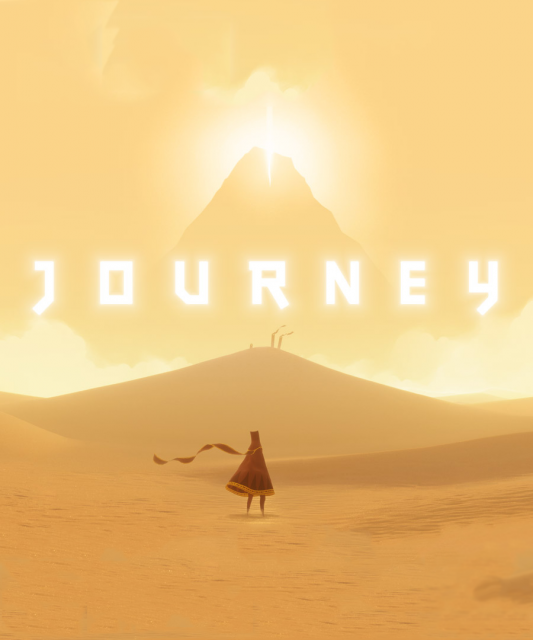Play, don't say.
Journey is a game about a Cloaked Traveler whose destination is to reach the top of a mountain peak.
Once you start a new game of Journey, a cutscene plays by showing the environment with multiple shots of sandy hills and a steady introduction to the silent protagonist: the Cloaked Traveler. As a player, you're in control of the Traveler throughout the whole game -- as you're seamlessly given movement control of it once you turn the camera behind the Traveler in the scene it's first shown in. Upon climbing up the first hill of the game, the camera slowly takes a back scene and control away from the player to present the far away mountain in the distance -- finishing off by being accompanied by some soft violin music and showing the title of the game on top of the screen.
As the scene plays out, it's obvious that getting to the mountain is your primary objective. The scene then flashes white and cuts back close behind the Traveler, thus instantly bringing you back in control. Within the scene, the sign is pointing out to you that a shining white symbol in the distance is where you'll most likely want to go. Once you're there, the scene then shifts to the side of the Traveler, connecting our attention to the symbol, and creates a scarf behind the Traveler's back. It is shown that the scarf created lets the player jump with the cost of some power. To regain that power, the player is shown that they can interact with floating pieces of cloth, and if they do, the pieces will carry you upward and refill your scarf power.
-Throughout the game, players can find multiple symbols that will increase the length of your scarf, allowing for more power and jumps players can make. However, they can only be discovered if the player takes their time and explore the area around them, so it creates this balance for knowing where one symbol can be hidden in and be rewarded for finding it.
After the player acquires the symbol, they can now proceed by following a path of gravestones, which leads to a slide down to some ruins and large ancient gates.
-With inspection, players will likely find a ruined structure if they follow the path. If the player chooses to check out the structure, they will come to a blank screen inside of the structure. If the player decides to interact with all of the gravestones next to the screen, the screen will then display a picture of history. Like the symbols, these ancient screens can be discovered by exploring the areas of the game. They don't expand the controls in any way, they're just here to show some ancient historical pictures to players who're interested, and that's it.
Once the player makes their way down to the ruins, they can climb up top and see a broken bridge. Across from the bridge is a statue which holds power to the gate behind it. As the player makes their way across, they can light up the gravestones around the statue, which will activate a bright circle in front of the statue. If the player interacts with the circle, the Traveler will then sit down and take control away. The screen flashes to white, showing what the Traveler sees in its viewpoint, and presents some past history of what the mountain's summit did for ancient Travelers during that time. The scene then flashes back out of the Traveler's vision in which the gate now opens up. The Traveler then stands back up, bringing back control to the player, and then allows them to continue their adventure.
All of what I said up to now was just the beginning of the game, and despite me writing a few paragraphs to explain it to you, the game shows it to you a lot better and simpler than I just did -- all of which aren't told with words. That's right, Journey is a "Show, don't tell" game that doesn't say a single word to you through the whole adventure (not even the Traveler speaks). The closest the player can make to get an interaction in this game is a callout command, and even then its only game-changing use is to interact with floating cloth.
So overall: the lack of communication, simple controls, intuitive level design, camera work, and interactions make Journey an immensely accessible game to experience. It's specially made all the better when the player progresses deeper and deeper into the game with so many emotionally dense moments, clever use of music, tragic stakes, and cutscene cinematics all waiting around the corner for you to witness. And man, this game is a treat to look at, too. From start to finish, this is a game I would highly recommend for you to experience all for yourself instead of looking at another's gameplay footage of it because it's that much of a personal single-player experience.
I don't need to tell you how wonderful this game is to play and witness, but I did just to try and convince you to get it. So please, if you have the time in your life to play a little rich Indie title, then look no further than Journey.
